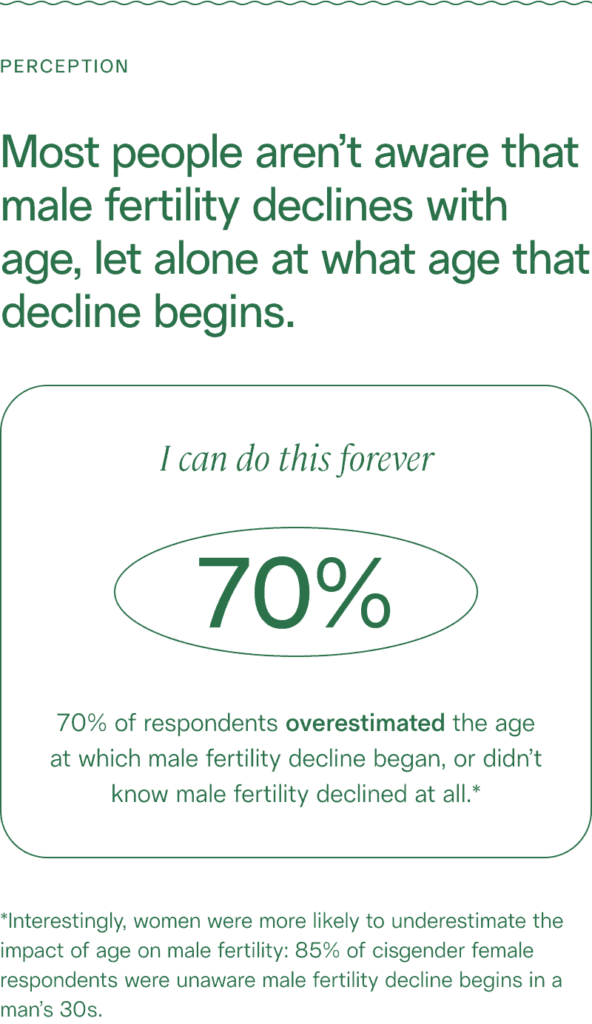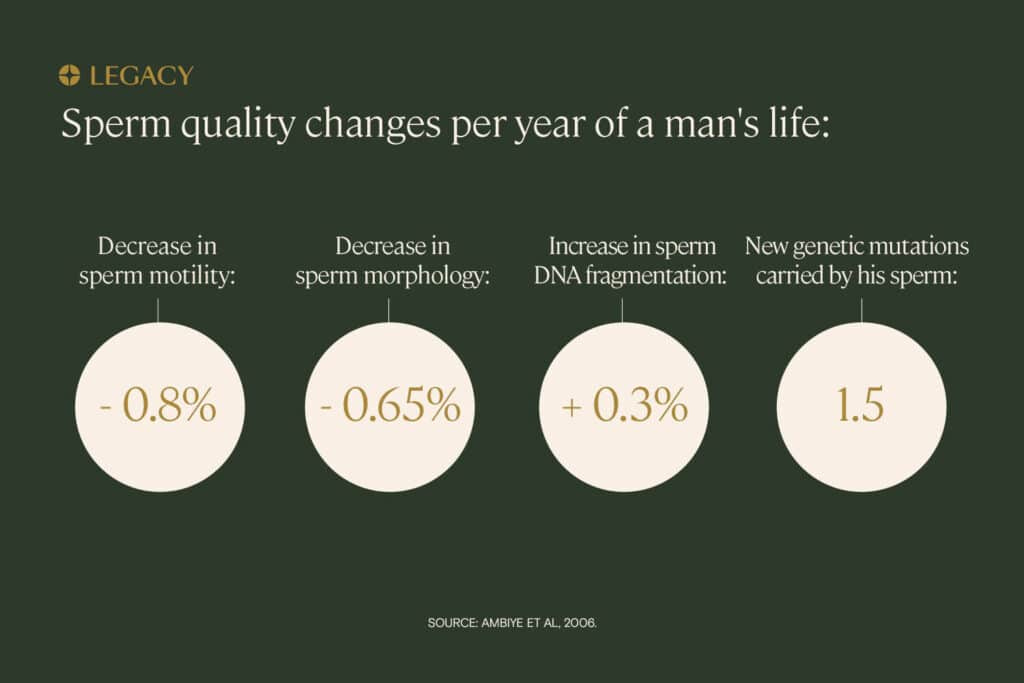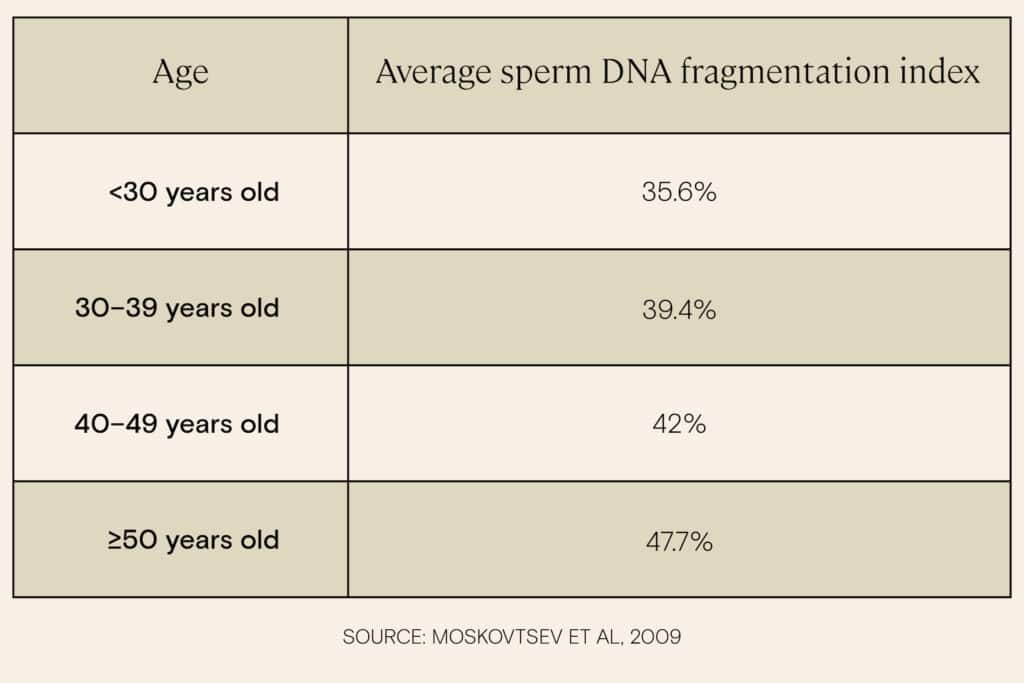When we talk about age and fertility, most people think about female fertility, since cis women are born with all the eggs they’ll ever produce. Sperm, on the other hand, is abundant, right? After all, healthy testes can produce several million sperm per day (approximately 1,500 per second).
The truth: While sperm production does not stop completely with age, there is a notable decline in the quality of the semen, which can be assessed by the sperm count, morphology, motility, and sperm DNA fragmentation.
But most people don’t seem to be aware of this decline. We conducted a survey of nearly 3,000 respondents to identify the gaps in male fertility knowledge among the general population. Approximately 7 in 10 respondents either overestimated the age at which male fertility starts to decline — or weren’t aware that male fertility declines with age at all.
In this article, we’ll reveal what the 2023 Sperm Report revealed about perceptions of age and fatherhood, how age and male fertility are connected, and what you can do to preserve your fertility if you want to become a parent later in life.
Findings from the 2023 Sperm Report
- The majority of individuals surveyed didn’t understand the impact of age on male fertility, revealing a broad lack of awareness.
- The average paternal age is at an all-time high across developed countries, while sperm counts are at an all-time low.
- Individuals can protect their fertility by adopting healthy lifestyle habits and banking their healthiest sperm while they’re young.
Legacy’s survey
Male fertility — including how it’s measured, factors that impact it, and changes in its trends globally — is something we talk about a lot here at Legacy, but we realized that not everyone is having these conversations. With that in mind, we wanted to get a pulse check on how much people really know about all things male fertility.
In November 2022, we set out to discover the knowledge gaps, uncover the most pervasive myths, and evaluate opportunities to educate everyone about health topics and questions that we’re all asking.
Our survey received 2,983 responses from respondents between the ages of 18 and 65. Of the group, 50% identified as cisgender men, 48% as cisgender women, and 2% as trans or nonbinary.*
*Note: when we refer to “women” and “men,” we include all people who self-identify as such.
Most respondents didn’t understand the impact of age on male fertility

The results of our survey revealed that most of us have no idea what actually impacts fertility. When asked to identify the factors that affect male fertility, over half of the respondents got it wrong.
Our results showed 70% of respondents either:
- overestimated the age at which male fertility decline begins or
- didn’t know male fertility declined at all.
The survey found that nearly half — 45% — of respondents didn’t know age affects a man’s ability to father a healthy child.
How age really affects male fertility
Knowing that age impacts male fertility is just the first step. What’s more important and helpful to understand is how age affects male fertility, how the change can be measured, and when the decline really begins.
There are several factors that can affect sperm quality and lead to fertility challenges:
- Low sperm count
- Poor sperm motility (the ability and efficiency of the sperm’s movement)
- Abnormal sperm morphology (the shape of the sperm)
- High sperm DNA fragmentation (damage to the genetic material within sperm)
Studies have found correlations between age and all of the above metrics. Research has shown there is a drop in sperm count of up to 2.6% per year of age. Meanwhile, sperm morphology decreases by around 0.65% per year of age.

Sperm motility is critical to successfully conceiving. The journey from the testes to the egg is long and full of obstacles that only the fittest sperm cells can overcome. A decline in the sperm’s motility may result in a lowered chance of becoming pregnant. Research has found that sperm motility drops by roughly 0.8% per year of age, leading many older individuals to struggle with infertility. Infertility is defined by the CDC as the inability to get pregnant after one year or longer of unprotected sex.
Each sperm cell carries DNA from the father that provides half of the genetic makeup of the child in cases of successful fertilization. As sperm quality decreases with age, so too does the integrity of the sperm’s DNA. The quality of the DNA can have a lasting impact on the risk of miscarriage following in vitro fertilization (IVF) and intracytoplasmic sperm injection (ICSI), the pregnancy, and the health of the baby.
Sperm DNA fragmentation also is likely to increase significantly with age. One study found that, or men under 35, the average percentage of sperm with genetic damage was 35.6%; for men over 50, it jumped to 47.7%.

One study found that higher paternal age increases the frequency of congenital diseases — including heart malformations and oral, palate, and lip cleft — and mental disorders — including autism, schizophrenia, and bipolar disorder.
When does male fertility start to decline?
Male fertility can begin to decline in individuals as young as 35 years old, and this decline gets steeper with age. One study found that male fertility fell at a rate of 21–23% annually, starting at 39 years old. This drop can be attributed to both a decline in sperm quality and lifestyle changes, such as becoming more sedentary as we get older.
Why? The mechanisms linked to a reduction in quality include decreased glandular functions, a reduced ability to repair cellular damage, structural changes to the male reproductive anatomy, and other impairments to sperm production.
Paternal age is the highest it’s ever been
Why is the relationship between age and male fertility important to understand?
The average age of fatherhood is on the rise globally. In the United States, the mean first-time paternal age has gone up from 27.4 years old in 1972 to 30.9 years old in 2015. In the United Kingdom, the average age of first-time fatherhood in 2020 was 33.7 years old, an all-time high since data collection began in 1964.
The delayed decision to have children stems from several factors, including increased life expectancy, higher divorce rates, improved access to assisted reproductive technology, and the higher cost of having kids, to name a few.
As people wait longer to start their journey to parenthood, there are an increased number of infertility and reproductive risks.
What you can do to protect your fertility
Once you understand that male fertility is likely to decline with age, you might be wondering: What can you do to protect your ability to have kids later in life?
The most secure way to ensure your fertility is protected against the natural impacts of aging is to freeze your sperm. Sperm freezing has become an increasingly accessible way for people to preserve their healthiest sperm while they’re young. Starting a family is a big decision that many are choosing to postpone until later in life. With sperm freezing, you can ensure you keep all your family-building options on the table.
There are several lifestyle changes you can adopt to improve your fertility and sperm quality, to ensure your sperm are as healthy as possible. These include eating a balanced diet, exercising regularly, and reducing alcohol and drug consumption. Maintaining a healthy lifestyle will provide lasting benefits to your reproductive health.
Want to learn more about how you can improve your sperm health? Check out our resource guide to learn all about how your lifestyle and environment can impact your fertility.



